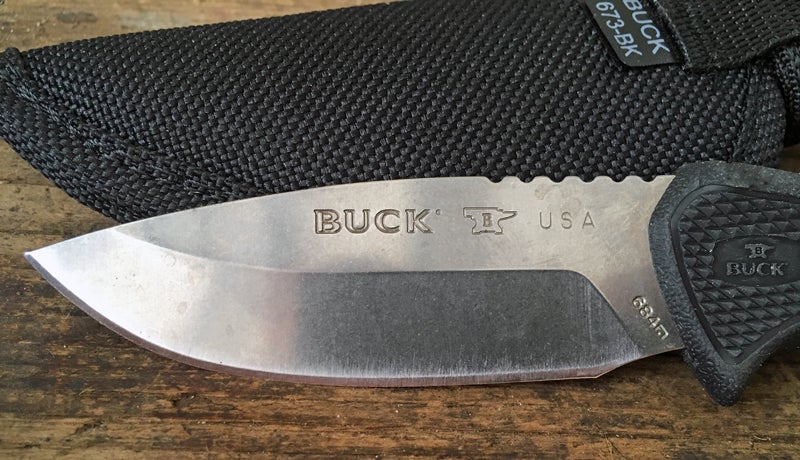Buck Knives 684 BuckLite Max II Small Knife Review
Russ Chastain 11.20.18

Earlier this year, I had the privilege of attending the 2018 SHOT Show Range Day, and brought home a few nice goodies. Among them were a few new Buck knives, including a new 110 lockback hunter and the handy little 684 BuckLite Max II Small Knife, which is the subject of this article. I discussed the 684 in a post about the best new hunting knives from SHOT 2018, in which I mentioned my desire to try this knife on a deer or hog. Well, it’s been used on two whitetails so far, so it’s time to talk about the Buck 684.

(Image © 2018 Buck Knives, Inc.)
It’s an affordable little knife, made in the good ol’ USA. It can be tough to find such things these days, but here it is.
Here’s what Buck has to say about it:
Smallest of the BuckLite Max II family, this skinning knife is made for details. Its full tang, ergonomic handle is constructed out of Dynaflex® rubber for superior grip, performance, and light weight. The drop point blade has been tumbled finished (less-porous, with improved corrosion resistance). Buck’s advanced Edge2x blade technology has been applied to the blade resulting in insane sharpness out of the box. Comes with a heavy-duty, black polyester sheath. Made in the USA.
Specs
- Blade Shape: Drop Point
- Blade Thickness: 0.090″
- Blade Length: 3.25″
- Overall length: 7.5″
- Weight: 2.8 ounces (4.15 ounces with sheath)
- Handle: DYNAFLEX® rubber
- Carry System: Sheath
- Model: 0684BKS-B
- MSRP: $33
The Blade
I’ve never sharpened this knife, but even after shucking two mature whitetail deer, the 684 will easily shave my arm — even out at the tip where it’s most-used. The steel is 420HC, and here’s what Buck says about it:
This is Buck’s standard blade material because it approaches the wear resistance of high carbon alloys while delivering the corrosion resistance of chromium stainless steels. Add our exclusive heat-treat process and you have a very user-friendly combination of superior corrosion resistance with excellent strength for wear resistance and durability. You also have a blade that is easy to resharpen. For best performance we harden to a Rockwell hardness of Rc 58.
The blade is also easy to clean, and the non-aggressive jimping on the rear of the spine is a nice touch.

(Photo © Russ Chastain)
The drop point blade shape makes it a natural for skinning, which is where I used the 684 the most. Per Buck:
This blade is full-bellied with a strong, thick point for heavier tasks. It can also be used as a general work knife. The top of the blade drops down toward the tip, which minimizes accidental puncturing while skinning.

(Photo © Russ Chastain)
The Handle
The handle is synthetic molded into the tang. They call it Dynaflex® rubber, and it has the slightly “grabby” feel you’d expect from rubber, which helps when your hands are slick from blood and fat. The checkering on the sides helps with grip and control, and the “dished” portion near the ricasso allows for easy natural grip between thumb and forefinger (or middle finger if your pointer is on the spine jimping).

(Photo © Russ Chastain)
Although the handle is lean and my hands are large, I found the 684 easy to use and control, and cleanup was a breeze.
There’s a lanyard hole in the handle, if you’re into that sort of thing.
The Sheath

(Photo © Russ Chastain)
The 684’s included 673-BK sheath is simple and useful. The black polyester sheath is well-stitched and lined with hard plastic throughout — with a tougher plastic insert to contain the blade. A strap wraps around the forward finger groove and snaps to retain the blade well. The belt loop is on the lean side, but long enough to easily accept up to a 2-inch belt (see photo at the top of this page).

(Photo © Russ Chastain)
Working With the 684
When I bagged a nice whitetail doe with Dad’s old 44 revolver Brün Hilda, I remembered the new Buck knives I’d been waiting to use. I swapped back and forth between this 684 and a 110 Folding Hunter® LT. The different blade shapes complement one another well, and I used the 684’s drop point mostly for skinning and the more-pointed 110 for cutting the critter apart, i.e. separating the legs from the body, removing the backstraps and tenderloins, etc.

(Photo © Russ Chastain)
The work went smoothly, and knife cleanup was easy enough afterward. When my nephew bagged his own deer the next day, he too used these knives to do the work and the results were the same.
After doing the job on a pair of adult Georgia whitetails, the 110’s blade was still reasonably sharp but would no longer shave if I used the curved end of the blade (which saw the most use). The 684, however, remains shaving-sharp from tip to ricasso.

Buck 684 skinning knife.
(Photo © Russ Chastain)
Conclusion
I’m a fan of the Buck 684. It’s refreshing to see a well-established knife company still making blades in the USA, while keeping them affordable. Although the MSRP is $33, I found it on sale for $19.99 at MidwayUSA, with a regular price of $22.99.
For 20 bucks you can get a handy little skinner that can last any hunter a lifetime — and it’s made right here in the USA. There’s nothing wrong with that!